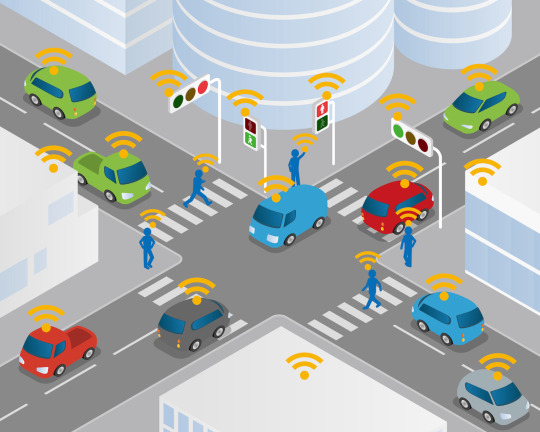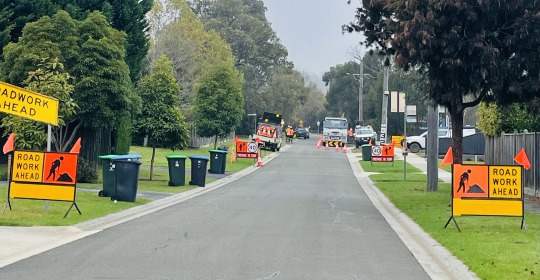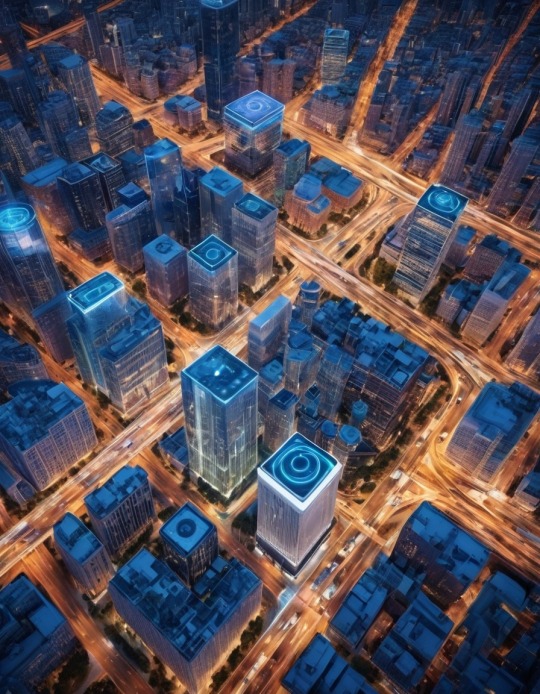#Traffic Management Plans
Explore tagged Tumblr posts
Text
Navigating Through Chaos: The Art of Effective Traffic Management Plans

Traffic Management Plans (TMPs) are comprehensive strategies designed to manage and regulate the flow of traffic in a particular area. These plans are crucial for ensuring the safety of pedestrians, cyclists, and motorists while also minimising congestion and disruptions to businesses and residents.
Effective TMPs require careful consideration of various factors, including Traffic flow, potential challenges, safety, and public awareness. In this blog post, we will explore the art of creating and implementing successful traffic management plans Melbourne, as well as the importance of proactive planning in ensuring smooth traffic flow.
Understanding Traffic Flow
To develop effective traffic management plans, it's essential to understand the factors that influence traffic flow. Various elements, such as road design, traffic volume, and infrastructure, can significantly impact the movement of vehicles.
Poorly managed traffic can lead to congestion, increased travel times, and heightened frustration among commuters. Therefore, TMPs play a critical role in optimising traffic flow and minimising the negative impact of congestion on the community.
Developing a Comprehensive Plan
The first step in creating a successful TMP is to assess the specific area where the plan will be implemented. This involves identifying potential challenges such as intersections with high accident rates, areas of heavy pedestrian activity, or sections of roads prone to congestion.
Additionally, the use of technology for monitoring and control, such as traffic cameras and smart signalling systems, can provide valuable data for developing a comprehensive plan tailored to the unique needs of the area.
Implementation Strategies
Effective implementation of TMPs requires close coordination with local authorities and emergency services. Collaboration with these entities ensures that the plan aligns with existing regulations and emergency response protocols.
Furthermore, communication and public awareness campaigns are vital components of successful implementation. Informing the public about upcoming changes, such as new traffic patterns or road closures, helps minimise confusion and inconvenience.
Ensuring Safety and Efficiency
Prioritising pedestrian safety is a fundamental aspect of any traffic management plan. Designating safe crossing points, installing pedestrian signals, and creating dedicated walkways contribute to a safer environment for pedestrians.
Moreover, minimising disruption to businesses and residents during the implementation phase is crucial. TMPs should aim to strike a balance between efficient traffic management and minimal disturbance to the daily activities of those in the affected area.
Case Studies and Success Stories
Exploring real-life examples of successful traffic management plans Melbourne provides valuable insights into the strategies that have yielded positive outcomes.
By studying these case studies and success stories, planners can glean important lessons and best practices for their own projects. Additionally, understanding the challenges faced and the solutions implemented in these scenarios can offer invaluable guidance for developing effective TMPs.
Conclusion
In conclusion, effective traffic management plans are essential for maintaining safe and efficient traffic flow in urban and suburban areas. By understanding the factors that influence traffic flow, developing comprehensive plans, and implementing strategies that prioritise safety and efficiency, communities can navigate through traffic chaos with greater ease.
Proactive planning and continuous improvement are key principles for ensuring the success of traffic management plans Melbourne, and by adhering to these principles, communities can minimise congestion and enhance the overall quality of life for their residents. Source By: Navigating Through Chaos: The Art of Effective Traffic Management Plans
0 notes
Text
youtube
The simple cul-de-sac is one of the greatest innovations of North American suburbia. By blocking through traffic, you create a residential street that’s safer and calmer for kids and that’s quieter and more community-oriented for adults. The suburbs have the advantage of being built like this from the start, but can we retrofit older cities with some of these principles?
#really loving the way it combines traffic calming with water management#montreal#canada#urban planning#Youtube
0 notes
Text
🚦 Delhi's Congestion Tax: A Step Towards Sustainable Urban Mobility 🌱 and Its Impact on Other States
Delhi is contemplating the introduction of a congestion tax aimed at alleviating traffic congestion and reducing pollution during peak hours. This initiative is part of a broader strategy to manage the increasing vehicular traffic in the city, particularly at key entry points. As one of the most congested cities in the world, Delhi’s approach could set a precedent for other urban centers in…
#Delhi Congestion Tax#Electric Vehicle#Electric Vehicles#Energy saving#India Urban Planning#Policy#Pollution Control#Public Transport#smart cities#Solar Power#Sustainable Transport#Traffic Management#Urban Mobility#Urban Monk
1 note
·
View note
Text
Discouraging people from driving is popular for improving urban air quality, but it’s unfair and unhelpful without viable public transport alternatives. Read more in my latest Medium article!
#urban planning#air quality#Bristol#public transit#sustainable transportation#photojournalism#city life#traffic calming#transport planning#urban transportation#transport engineering#traffic management#city planning#traffic reduction
0 notes
Text
Monsoon Mayhem: Jamshedpur Grapples with Waterlogging
Moderate Rainfall Causes Significant Disruption in Key Areas Jamshedpur’s drainage infrastructure struggles to cope with recent downpour, highlighting need for improved stormwater management. JAMSHEDPUR – Substantial waterlogging has resulted in traffic disruptions and resident frustration in numerous regions of the city as a result of recent moderate rainfall. Over the past 24 hours, the city…
#जनजीवन#drainage infrastructure#Jugsalai flood concerns#Life#monsoon in Jamshedpur#monsoon safety guidelines#municipal response to flooding#stormwater management#Tata Pigment Road waterlogging#traffic disruption due to rain#urban planning for rainfall#urban waterlogging
1 note
·
View note
Text
Infra Engineering Services
INFRA was established in 2021 by a team of highly skilled traffic engineers who brought together more than two decades of collective experience garnered from their previous roles at some of the most prominent traffic management companies and traffic engineering consultancies across Australia. Motivated by a shared vision to revolutionize the industry, INFRA introduced a new paradigm in delivering traffic engineering services, emphasizing a service-oriented, client-first approach. The company specializes in crafting detailed traffic plans and comprehensive traffic engineering reports, catering specifically to the needs of the construction, traffic management, and asset management sectors. This expertise ensures that INFRA is well-equipped to handle various industry demands, setting new standards for excellence in traffic engineering solutions.
Website: https://www.infraengineering.com.au/
Address: Suite 4863 805/220 Collins St, Melbourne, VIC, 3000, Australia
Phone number: +61 1300268948
Business Hours: Mon - Sat: 07:00 am – 09:00 pm Sunday - Closed
1 note
·
View note
Text
Construction Management Plan: Ensuring Success in Every Build
In the realm of construction, a well-crafted Construction Management Plan (CMP) stands as the cornerstone of project success. This comprehensive document serves as a roadmap, guiding every aspect of a construction project from inception to completion. Let's delve into the intricacies of a CMP and explore why it is indispensable for ensuring smooth, efficient, and successful construction endeavors.

The Blueprint of Success
A Construction Management Plan is akin to a blueprint for a building - it outlines the steps, resources, timelines, and responsibilities essential for the successful execution of a construction project. This detailed roadmap not only helps in coordinating various activities but also ensures compliance with regulations, safety standards, and environmental considerations.
Key Components of a CMP
A robust Construction Management Plan typically includes:
Project Overview: A detailed description of the project scope, objectives, and stakeholders involved.
Timeline and Milestones: Clear timelines for each phase of the project, including key milestones and deadlines.
Budget and Resources: Allocation of resources, cost estimates, and financial planning for the project.
Risk Management: Identification of potential risks, mitigation strategies, and contingency plans.
Quality Control: Procedures for ensuring quality standards are met throughout the construction process.
Health and Safety: Protocols for maintaining a safe working environment for all personnel on-site.
Environmental Impact: Strategies for minimizing environmental impact and adhering to sustainability practices.
Benefits of a Well-Structured CMP
Efficient Project Management: A CMP streamlines project management by providing a clear roadmap for all stakeholders, reducing delays and ensuring efficient resource allocation.
Risk Mitigation: By identifying potential risks and outlining mitigation strategies, a CMP helps in minimizing disruptions and unexpected costs.
Compliance and Accountability: Ensuring compliance with regulations and standards, a CMP holds all parties accountable for their roles and responsibilities.
Cost Control: Through detailed budgeting and resource allocation, a CMP helps in controlling costs and avoiding budget overruns.
Quality Assurance: By setting quality standards and monitoring procedures, a CMP ensures that the final deliverable meets the desired quality benchmarks.

Implementing a Successful CMP
To create a successful Construction Management Plan, consider the following steps:
Collaborative Planning: Involve all key stakeholders in the planning process to ensure alignment of goals and expectations.
Clear Communication: Maintain open communication channels to keep all parties informed and address any issues promptly.
Regular Monitoring and Updates: Continuously monitor progress, update timelines as needed, and adapt to changing circumstances.
Adaptability: Be prepared to adjust the plan as necessary to accommodate unforeseen challenges or opportunities.
Documentation and Reporting: Keep detailed records of all activities, decisions, and changes to track progress and ensure transparency.
Conclusion
In the dynamic world of construction, a well-crafted Construction Management Plan is not just a document but a guiding light that leads projects to successful completion. By outlining objectives, timelines, resources, and responsibilities, a CMP ensures that every construction endeavor is executed with precision, efficiency, and quality. Embrace the power of a comprehensive CMP, and watch your construction projects soar to new heights of success!
0 notes
Text

0 notes
Text
When deciding who to work for there is a sliding scale of employers that goes from lil mom and pop shops up to corporate monoliths. I have worked at both ends of the spectrum and I can pretty definitively say that tiny businesses are hands down the most insane employers.
The sweet spot is a place that has like 10-20 stores; that’s the best possible work environment. They’ll be polished enough to have protocols that make work structured, but not so bogged down with bureaucracy that nothing can ever get done.
This story is not from that sweet spot. This story is from my time working at Oil and Vinegar. Now, like many little franchise stores, the idea was solid. There was on tap imported olive oil and vinegar and it was really delicious. Top shelf. Unfortunately, each location was like the Wild West because owners varied wildly.
My owner was the human embodiment of Mr. Krabbs. His eyes were just constant dollar signs. Throughout my training he informed me of the price of every single piece of equipment I touched and how much it cost to replace it.
He had cameras set up to watch us, and an app on his phone to access the live feed. He’d call us to ask what we were doing when he’d just checked a camera to make sure we were being honest.
Now, the trouble was he had two locations. His location further south did amazing. It was way more centrally located and got three times the foot traffic. The one I worked in was in the snottiest mall possible in Arizona and consequently the rent was through the roof.
It was not going well for my store. We didn’t get as much traffic, so there was only so much I could do in a day. I could dust, sweep, and wait for customers. I read a lot and was frank when he called to interrogate me. I always asked for additional tasks but he never had any. What could I do to prop up a failing business?
But this man was convinced there was some Secret Reason that the store I was in was doing worse. He crunched numbers, looked at staff, and eventually hit upon the most insane possible solution.
We used too much toilet paper.
We were probably stealing toilet paper! Bleeding him dry one single ply square at a time! How dare we need to use the bathroom?! His south location used half as much toilet paper as we did, we must be thieving little monsters!!!!
Friends. The south location was populated entirely by men. My location had three people on staff who had to sit to pee. It was so blindly transparently the source of the discrepancy but this man was convinced we were making off with toilet paper to bankrupt him.
So he implemented what he believed to be an entirely reasonable response to this base treachery. We were allowed to have one roll of toilet paper. At any given time, one roll was permitted to us. This was so transparently unhinged that we protested but he insisted. If we were low on toilet paper we needed to call him to drop off a roll that he brought from his home. Smiling jovially, he assured us he lived so close by that it would be no problem!
When we needed to call him often for more he started tearing his hair out. What were we using toilet paper for?! Why wasn’t his genius plan to stop our scandalous waste working??!
Finally, the manager, the only man on staff had to pull the owner aside and be like, “Look, man, their bladders are smaller. They need to wipe every time they pee. They need to pee even more on their period. Is this really the hill you want to die on?”
Yes. It was. The manager was fired unrelated reasons and denounced as a traitor. The toilet paper ration lasted until I quit and probably until the store closed six months later.
5K notes
·
View notes
Text
5 Key Elements for Successful Traffic Management Plans
Traffic management plans are essential for ensuring smooth flow and safety on our roads. Whether it's a construction project, a special event, or simply managing daily traffic, having a well-thought-out plan in place is crucial.
In this article, we'll explore five key elements that are vital for successful traffic management plans.
Comprehensive Analysis and Planning
Before implementing any traffic management plans Canberra, it's crucial to conduct a comprehensive analysis of the area in question. This analysis should consider factors such as traffic volume, peak hours, road conditions, and any existing traffic regulations. By understanding the unique characteristics of the area, planners can develop a more effective plan tailored to its specific needs.
During the planning phase, it's essential to involve all stakeholders, including local authorities, transportation agencies, and community members. This collaborative approach ensures that diverse perspectives are taken into account, leading to a more robust and inclusive traffic management plan.
Clear Communication Strategies
Effective communication is key to the success of any traffic management plan. This involves not only disseminating information about the plan itself but also providing regular updates and addressing any concerns or feedback from the public.
Clear signage, digital message boards, and communication through various media channels can help keep motorists and pedestrians informed about changes in traffic patterns or temporary closures. Additionally, establishing a dedicated hotline or website where people can access real-time information can enhance transparency and trust in the traffic management plan.

Flexible and Adaptive Approach
No traffic management plan is set in stone. Conditions on the road can change rapidly due to factors such as weather, accidents, or unforeseen events. Therefore, it's essential for planners to adopt a flexible and adaptive approach that allows for adjustments on the fly.
Regular monitoring and evaluation of the traffic management plan are crucial to identify any areas that may need improvement or modification. This may involve collecting data on traffic flow, conducting surveys, or soliciting feedback from stakeholders. By staying proactive and responsive, planners can ensure that the traffic management plan remains effective in addressing evolving needs and challenges.
Safety as the Top Priority
Above all else, safety should always be the top priority in any traffic management plan. This includes not only the safety of motorists but also that of pedestrians, cyclists, and workers in construction zones.
Measures such as speed limits, designated pedestrian crossings, and temporary barriers should be implemented to minimise the risk of accidents and injuries. Additionally, providing adequate lighting and clear markings can help improve visibility and reduce confusion on the road.
Continuous Monitoring and Improvement
Successful traffic management plans Canberra are not static documents but rather dynamic processes that require ongoing monitoring and improvement. This involves collecting data on key performance indicators, analysing trends, and identifying areas for enhancement.
Regular meetings and reviews with stakeholders can provide valuable insights and input for refining the traffic management plan over time. By embracing a culture of continuous improvement, planners can ensure that their traffic management plans remain effective and responsive to the needs of the community.
Final Thoughts
Traffic management plans play a crucial role in ensuring the safe and efficient movement of people and goods on our roads.
By incorporating the key elements discussed in this article – comprehensive analysis, clear communication, flexibility, safety, and continuous improvement – planners can develop traffic management plans Canberra that not only meet the needs of today but also anticipate the challenges of tomorrow.
0 notes
Text
Ensuring Safety Through Planning and Communication in Road Construction
The twin pillars of Planning and Communication in Road Construction Safety are fundamental for ensuring the well-being of workers and the public. This article will delve into why meticulous planning and effective communication are critical in managing the unique risks associated with road construction projects and how they can significantly enhance safety outcomes. The Role of Planning in Road…

View On WordPress
#construction communication#construction industry#construction technology#emergency response#hazard identification#planning in construction#project management software#Risk Mitigation#road construction safety#Safety Culture#safety management#safety protocols#Safety Training#traffic management#Workplace Safety
0 notes
Text

At Safety Education, our Traffic Management Plans Course is designed to equip individuals with comprehensive knowledge and practical skills essential for effective traffic management in various environments. This course, available at https://safetyeducation.au/traffic-management/, is tailored to meet the needs of professionals, businesses, and organizations seeking to ensure safety and efficiency in handling traffic operations.
0 notes
Text
Importance of a Comprehensive Traffic Management Plan for Improving Road Safety

A comprehensive traffic management plan is crucial for improving road safety in several ways. Road safety is a paramount concern, as traffic accidents can result in injuries, fatalities, property damage, and economic costs. A well-thought-out traffic management plan can help mitigate these risks and create safer road environments for all users. Here are some reasons why a comprehensive traffic management plan is important for improving road safety: reduced accident rates, minimize severity of accidents, improves visibilty & signage, magaes traffic congestion, enhances pedestrian & cyclist safety, enforces speed limits, emergency response, education & awareness, data-driven decision making, adapatation to changing condition. In conclusion, a comprehensive traffic management plan is a critical tool for improving road safety by reducing accidents, minimizing their severity, and creating an environment where all road users can travel safely. Such plans should be developed, implemented, and continually evaluated to ensure they remain effective in addressing the evolving challenges of road safety.
0 notes
Text
Traffic Woes on Mango Bridge Prompt Chamber's Appeal
Business group urges officials to tackle daily congestion, proposes solutions Singhbhum Chamber of Commerce and Industry appeals to local officials to address severe traffic jams on Mango Bridge. JAMSHEDPUR – The Singhbhum Chamber of Commerce and Industry has formally requested that East Singhbhum Deputy Commissioner Ananya Mittal and SSP Kishore Kaushal address the persistent traffic congestion…
#Ananya Mittal Jamshedpur#जनजीवन#East Singhbhum traffic solutions#Jamshedpur public transportation#Jamshedpur traffic management#Jamshedpur urban planning#Kishore Kaushal traffic management#Life#Mango Bridge commuter issues#Mango Bridge improvement proposals#Mango Bridge traffic congestion#Singhbhum Chamber of Commerce appeal
0 notes